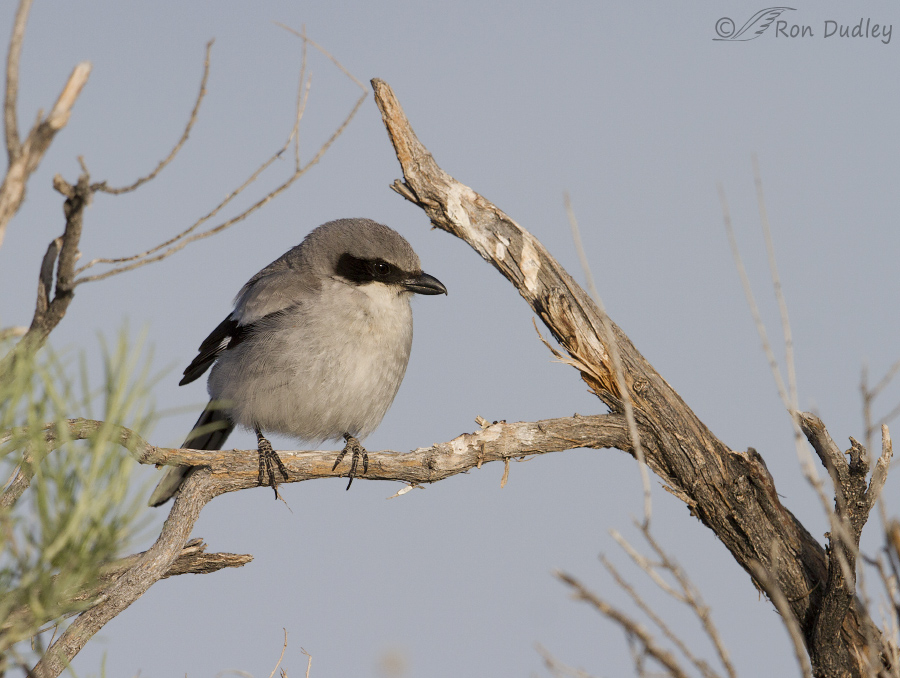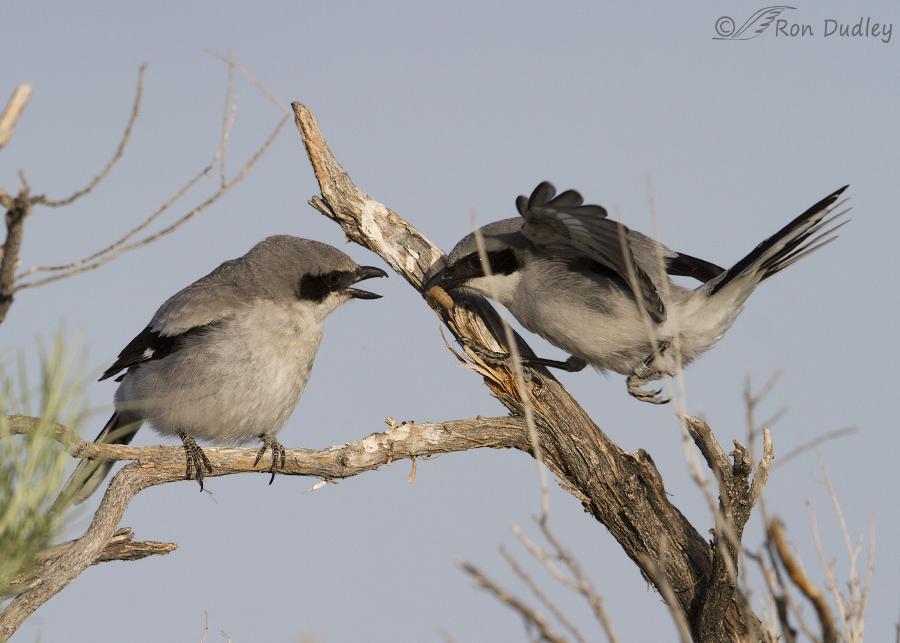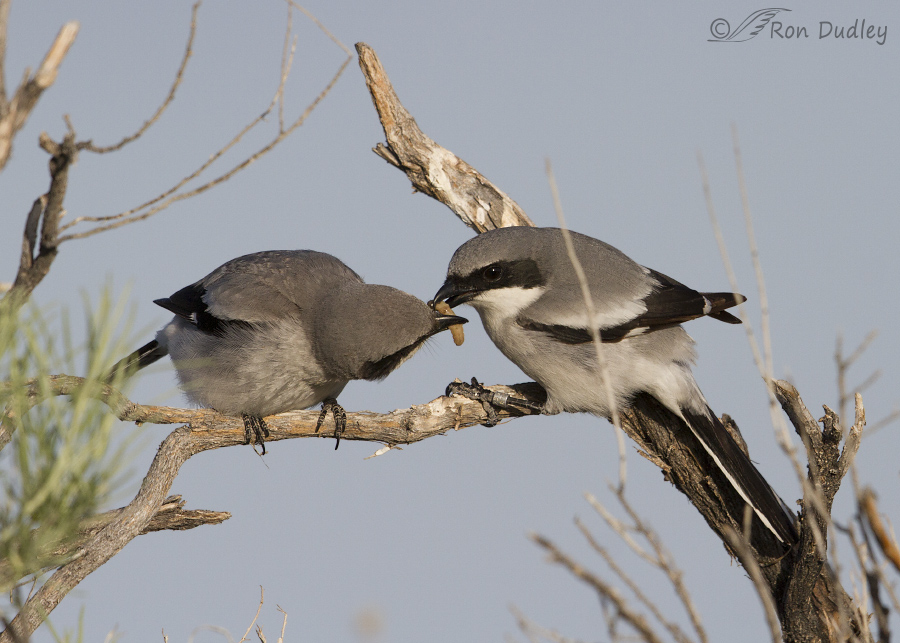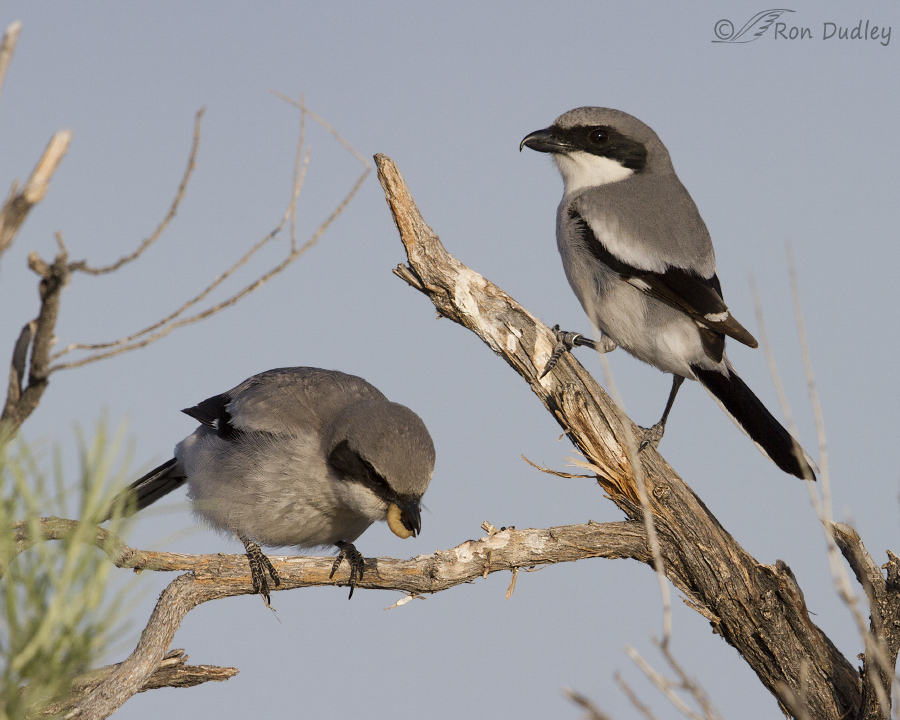Male Loggerhead Shrikes feed their mates beginning with the formation of pair bonds in early spring and such behavior continues throughout the incubation and nestling periods.

1/3200, f/6.3, ISO 500, Canon 7D, Canon EF500mm f/4L IS II USM, not baited, set up or called in
Two days ago I watched (and photographed) shrike mate-feeding behavior on this perch so yesterday morning when I saw this female patiently waiting on the same perch I anticipated the same behavior was about to occur again.

1/3200, f/6.3, ISO 500, Canon 7D, Canon EF500mm f/4L IS II USM, not baited, set up or called in
I was right. It wasn’t long before the male flew in with a tasty insect larvae snack. Here he’s about to land on the perch in front of the female. This male has been banded by my friends at the Great Salt Lake Institute (GSLI) out of Westminster College (they’re doing a study of how mercury compounds move through the food chain around the Great Salt Lake).

1/3200, f/6.3, ISO 500, Canon 7D, Canon EF500mm f/4L IS II USM, not baited, set up or called in
He offered the prize to the female…

1/3200, f/6.3, ISO 500, Canon 7D, Canon EF500mm f/4L IS II USM, not baited, set up or called in
and she accepted.

1/3200, f/6.3, ISO 500, Canon 7D, Canon EF500mm f/4L IS II USM, not baited, set up or called in
I thought she might take it to her presumed nestlings but she quickly gobbled it down and soon both birds flew off.
Because I observed the same behavior on the same perch the day before I’m beginning to think of this dead sagebrush branch as some sort of “feeding station”. I’ll post images of the previous feeding episode sometime in the near future.
Ron
Note: Because I can read some of the band numbers of the male in hugely cropped versions of some of these images I’ve sent one of those photos to GSLI in case that information is meaningful to them.


There is quite a lot study concerning mercury in Wisconsin loons and most of it comes from coal fired energy plants. Both Wisconsin and Michigan DNR have ongoing studies concerning mercury in rivers. Eaglets are take out of nests in WI to determine their blood mercury levels.
I had my aw-w moments looking at these tender gestures and cringed too, when I read about the mercury.
What a privilege to see – for you and for us. Thank you. I am however, still cringing at the necessity for a study to see ‘how mercury compounds are moving through the food chain’. As a species we really aren’t house-trained are we?
I cringe too, Elephant’s Child. Mercury can be such an insidious element in the environment in some of its forms and we really don’t understand the effects of many of its compounds.
I love these darling image, Ron!!
Thanks, Lois.
Wonderful!
Thank you, Nala.
Lovely images of this appealing behavior!
Thanks, Deborah.
Great series, Ron! Had a chance to observe the same behavior day before yesterday. The male Loggerhead Shrike brought prey on two different occasions, the female accepted both times, then they both continued to feed independently. I’ll revisit the area next week and search for a nest.
Must go. Gotta take my mate a snack….hope she accepts it….
“Gotta take my mate a snack….hope she accepts it….”
Wally, I read your comment on my phone while I was up in the mountains shooting this morning. Gave me a good chuckle.
I wonder where those mercury compounds came from…
Because of you I became very fond of “Picanço Real”.
Great series.
Thanks for sharing this beauty.
Jorge, There are a few industries around the lake that are the primary source of those mercury compounds (it’s a huge lake). The real effects of those compounds on the food chain are not well understood – thus the study.
Wonderful series Ron, many thanks!
I am sure GSLI will appreciate knowing the band number. That information is very valuable in a long or short term study.
Thanks, Dick. I have many images of this male taken over two days (some taken with teleconverter attached). If GSLI shows any interest I may research those images to see if the band has rotated on the leg enough to read the entire band.
Such wonderful behavioral shots Ron! I observed something similar in Cedar Waxwings, except they appeared to share the meal, but maybe not, they were so high up in a tree it was difficult to see. Of course I was unable to get any decent shots. I envy you the low perches. Thanks for sharing!
Charlotte
That’s one nice thing about shooting on Antelope Island, Charlotte – virtually all of the perches are low. Thank you.